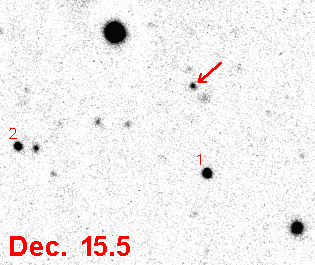Explanation: Gamma-ray bursts seem to be the most powerful explosions in the Universe. Yet their sources continue to elude researchers who stand in awe and frustration at the bursts' transient, enigmatic behavior. The blinking gif above illustrates the latest hard-won result in the quest to identify and understand the nature of the bursters. These Apache Point Observatory optical images from Monday and Tuesday this week have helped identify a faint, fading object (red arrow) near the position of a gamma-ray burst. The gamma-ray burst triggered satellite observatories on Sunday, December 14th. Faint stars near the constellation Ursa Major (the Big Dipper) also appear in these "negative" images of the sky. Though thousands of bursts have been detected by satellites sensitive to gamma rays, it is likely that this object represents only the third known optical counterpart to a gamma-ray burst.
1999 2000 2001 2002 2003 2004 2005 2006 2007 2008 2009 2010 2011 2012 2013 2014 2015 2016 2017 2018 2019 2020 2021 2022 2023 2024 2025 |
Yanvar' Fevral' Mart Aprel' Mai Iyun' Iyul' Avgust Sentyabr' Oktyabr' Noyabr' Dekabr' |
NASA Web Site Statements, Warnings, and Disclaimers
NASA Official: Jay Norris. Specific rights apply.
A service of: LHEA at NASA / GSFC
& Michigan Tech. U.
|
Publikacii s klyuchevymi slovami:
optical counterpart - gamma-ray burst - gamma-vspleski - opticheskoe poslesvechenie
Publikacii so slovami: optical counterpart - gamma-ray burst - gamma-vspleski - opticheskoe poslesvechenie | |
Sm. takzhe:
Vse publikacii na tu zhe temu >> | |
